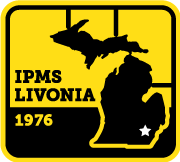Monogram Midget Racer
M. Kendel – September 2020
In 1954 Monogram Model Company released their very first plastic model car kit. This kit was the Midget Race Car shown below. At that time, midget racing was the most common and popular racing in the country as the cars were cheap and plentiful and the action was both exciting and brutal. There were midget racing circuits in most sections of the country and the prize money was significant for that day and time.
The Monogram kit portrays a pretty generic version of the species with very rudimentary suspension and interior, and a representation of what appears to be an Offenhauser midget engine. It also comes with a driver figure and a piece of clear plastic for the windshield. (This latter plastic is, as far as I can tell, impervious to any glue known to humankind and I have never seen one of these models displayed with the windshield.)

This model appears to be an example of the early “box scale” types. In the early days of plastic models, the scale of the product was often determined largely by the size of the box that it was to be packaged in and the boxes were designed to fit conveniently on store shelves. This particular model scales out to about 1/18.5 depending on which features you measure.
In those “early” days, the materials to build models with were very limited. By the time I had started building models in the late ‘50’s, Testors had released their widely-used line of “square-bottled” enamels and some basic spray colors.
Having recently completed a highly detailed and time consuming project, I decided that I wanted to do something simple and fun, so I got this kit out of my “stash”. I decided that I would build the kit using only what was in the box and what was available back in the day. Hence, the old-fashioned Testors tube of styrene cement, the “square-bottle” enamel, and a can of Testors red spray paint were acquired. All of the painting on the model except the red body was done with Testors enamel and a brush, including the silver.
As can be seen below, the kit is very basic and, as the molds were about 50 years old when this re-issue of the kit was made, there are significant flash and alignment issues.


Because I would be using no filler, the de-flashing and clean-up of the parts was probably the most time consuming part of the actual assembly. I also ended up “mashing” a lot of the joints so there wouldn’t be any seams that had dips in them.
Of course, painting was also time consuming and somewhat frustrating. (My old fingers are a lot shakier than they were when I first built this model in the dim and misty past!)
There were also a number of times that I was sooooo tempted to cheat just a little and throw in this added bit of detail or that extra type of finish that wasn’t available back then… but then the whole point of the exercise would have gone out the window.
I did end up using fine sandpapers that were probably available back then but not commonly used by the modeling public. And I did polish up the finish with some polishing compound but that was “kosher” by my rules because it has been around for centuries. So what you see here is what you could have seen back then…
And, you know what? Yes, it actually was fun not to have to worry about a flawless show finish, or scratch built bits, or photo-etched whatever! On the other hand, there’s this 1/12 scale project calling my name now…





